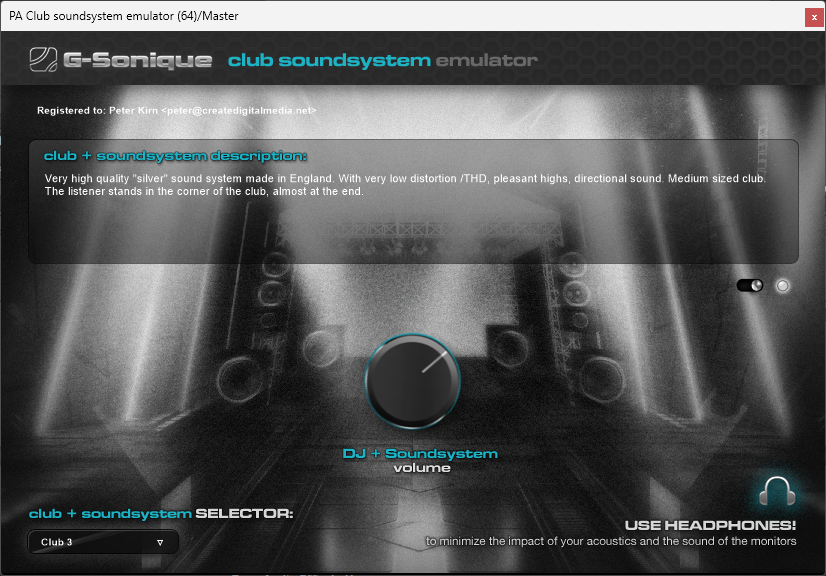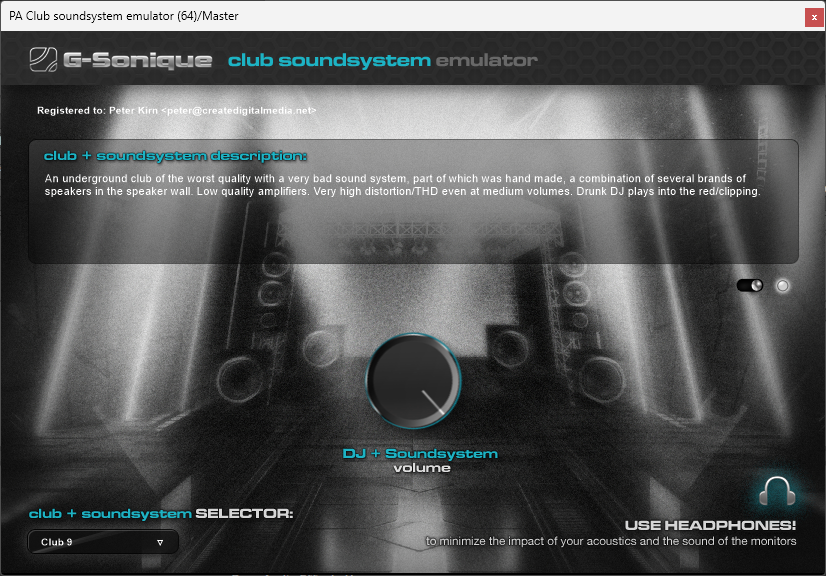From perfectly tuned, powerful sound systems to blown-out speakers and DJs playing in the red, G-Sonique’s PA Club plug-in emulates nightlife sound. I’ve been testing it, and the results are impressively realistic.
G-Sonique is a boutique, independent developer out of Piestany, Slovakia (that’s about an hour out of Bratislava by train or car). They don’t get a whole lot of attention, and they develop exclusively for Windows, but they’ve been steadily cranking out really solid plug-ins since 2007. (Also, I award bonus points to anyone who has a product called Psychedelic Spiral.)
Now, any veterans out there – admit it, the first time a lot of you heard a production on a big sound system (or worse, a dodgy sound system), you probably got a surprise. PAs are built for high sound pressure, and they perform differently than studio monitors, by design. And then you have the often echo-y characteristics of the space, which are the opposite of a bedroom or treated studio.

G-Sonique’s plug-in effort here emulates all three of the variables you’re likely to encounter in venue sound: the mixer/PA behavior, the room reflections, and, amusingly, also the impact of DJs playing “into the red” and distorting and oversaturating the signal.
The interface is dead-simple: there’s a big dial for volume, a drop-down for club presets, and a bypass switch. There’s a nice mix of different sizes of venues and condition of sound system and DJ from excellent/perfectly tuned to “the PA has seen better days and the DJ is trashed and thinks those little red LEDs on the master channel are an indicator everything is awesome.”

When I got the press release, I assumed this would just be a pretty dumbed-down set of convolutions or something, but I had to try it for the novelty factor alone. In practice, you can hear they’ve done some hard work. G-Sonique confirms that there’s not only a convolution reverb to model the venue acoustics (that being the obvious part), but also modeling signal behavior. That includes processors like multi-band crossovers and limiters, DJ clipping, and the amplifer’s Total Harmonic Distortion (THD). It’s convincing enough that you can hear the strain of the amp and mixer (and my stress level as I watch a DJ redline from the booth), as you turn up the knob.
At this price, it’s a no-brainer to recommend as a learning tool to novice producers. G-Sonique promises it can be used not only with techno, but other genres including band music. And the emulation is good enough that you might consider it if you’re on Windows or have a spare PC around. Now that I do have it sitting on my PC laptop, I think I may use it to freshen my ears on the demo folder, honestly – and it’s tempting to try it on some creative production use, too, since it is a plug-in and so you can use the results as you like.
So you can really hear how it works, I’m using a really simple pattern on a 909 kit from the Ableton Live library and scrolling through the presets:
G-Sonique says they did a lot of research for this one, working with DSP engineers, live sound engineers, DJs, and producers. The artists consulted include “Toxic Elements, Synthaix, DJ Byg Byzniss or DJ Adidaso with Slovakian slav squad.” I have no idea who any of those people are, but I’m 100% there for the last one on name alone.
G-Sonique PA club soundsystem emulator
So – uh, I’m sure I have Slovak friends who can relate to this, seriously – you’re all set to play a burnt-out PA right after a drunken DJ red-lining the board. (I got to do that once in neighboring Czech, but not yet Slovakia.)
G-Sonique’s PA Club Soundsystem emulator ships as a 32-bit or 64-bit Windows VST, for 29 EUR. (17.90 EUR intro price for the first 70 sales – don’t know if they’ve hit that already.)
Okay, I looked. DJ Adidaso is exactly as I expected sound-wise, but I was not ready for this image.
Úspech! Pekný piatok všetkým!
Plenty more where that came from. Pickled for your pleasure: